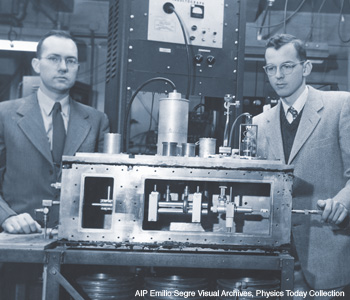Feature
Reflections on the First Maser
Before the laser, there was the maser, and, before that, an idea: to build a microwave amplifier using ammonia molecules. Jim Gordon takes us back to the early 1950s, when he had to decide whether Charles Townes’s vision for creating a coherent oscillator was promising enough for him to commit to for his Ph.D. project.
 Townes and me (right) with the second maser, with its innards exposed. From left to right are the ammonia source, the quadrupole focuser and the resonant cavity. My left hand is on the cavity tuning control.
Townes and me (right) with the second maser, with its innards exposed. From left to right are the ammonia source, the quadrupole focuser and the resonant cavity. My left hand is on the cavity tuning control.
In April 1954, when five of us were having lunch in the Columbia teacher’s college cafeteria, Charles Townes proposed that we name the coherent oscillator that we had just created. He vetoed any name that ended in “-tron.” Before we left, we had created the name maser, an acronym for “microwave amplification by stimulated emission of radiation.” Before long, Arthur Schawlow had re-imagined the maser acronym to mean “money acquisition schemes for expensive research.” Back then, none of us could have imagined how critical the maser would be in shaping optical technology in the 20th century and beyond. These are my recollections of how the maser came to be.
…Log in or become a member to view the full text of this article.
This article may be available for purchase via the search at Optica Publishing Group.
Optica Members get the full text of Optics & Photonics News, plus a variety of other member benefits.
